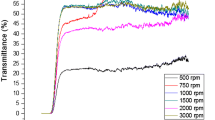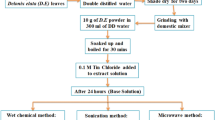Abstract
Tin oxide (SnO2) nanoparticles were prepared by green synthesis process using extract of leaf from buckthorn and tin (IV) chloride pentahydrate (SnCl4·5H2O). The materials calcined at 400 °C for 3 h to produce of SnO2 NPs. SnO2 nanoparticles were characterized by X-ray diffraction, scanning electron microscope, optical microscope, and optical spectroscopy techniques.The result of XRD showed formation tin oxide nanoparticles with tetragonal crystal structure. The optical properties were enhanced with rising concentration from 1.25gm/100 ml to 5gm/100 ml. The optical absorbance (A) enhanced of 42.3% at λ = 340 nm (UV-spectrum), 55.8% at λ = 540 nm (VIS-spectrum) and 53.3% at λ = 840 nm (NIR-spectrum). The energy gap is reduced from 3.31 eV to 3.16 eV while the SnO2 concentration increases from 1.25gm/100 ml to 5gm/100 ml. The obtained results showed that SnO2 thin film are appropriate for numerous electronic, photocatalytic and photonics fields. The SnO2 thin film employed for self cleaning against organic dyes. The results indicate that the SnO2 NPs are very important to apply as a coating nanolayer for self cleaning to obtain on cleaning environment.









Similar content being viewed by others
Data availability
Yes, the data are available.
References
Abu-Dief, A.M.: Development of metal oxide nanoparticles as semiconductors. J. Nanotechnol. Nanomater. 1(1), 5–10 (2020)
Ahmed, H., Hashim, A.: Structure, optical, electronic and chemical characteristics of novel (PVA-CoO) structure doped with silicon carbide. SILICON 13, 4331–4344 (2021). https://doi.org/10.1007/s12633-020-00723-8
Akpan, U.G., Hameed, B.H.: Parameters affecting the photocatalytic degradation of dyes using TiO2 -based photocatalysts: a review. J. Hazard. Mater. 170, 520–529 (2009). https://doi.org/10.1016/j.jhazmat.2009.05.039
Amin, P.O., Ketuly, K.A., Saeed, S.R., Muhammadsharif, F.F., Symes, M.D., Paul, A., Sulaiman, K.: Synthesis, spectroscopic, electrochemical and photophysical properties of high band gap polymers for potential applications in semi-transparent solar cells. BMC Chem. (2021). https://doi.org/10.1186/s13065-021-00751-4
Anu, N.T., Kumar, K., Sharma, K.K.: Application of Co-doped copper oxide nanoparticles against different multidrug resistance bacteria. Inorg. Nano-Metal Chem. 50(10), 933–943 (2020). https://doi.org/10.1080/24701556.2020.1728554
Avramescu, M.-L., Chénier, M., Beauchemin, S., Rasmussen, P.: Dissolution behaviour of metal-oxide nanomaterials in various biological media. Nanomaterials 13, 26 (2023). https://doi.org/10.3390/nano13010026
Balkrishna, A., Kumar, A., Arya, V., Rohela, A., Verma, R., Nepovimova, E., Kuca, K.: Phytoantioxidant functionalized nanoparticles: a green approach to combat nanoparticle-induced oxidative stress. Oxid. Med. Cell. Longev. 2021, 1–20 (2021). https://doi.org/10.1155/2021/3155962
Balkrishna, A., Rohela, A., Kumar, A., Mishra, S., Arya, V., Kala, V., Thakur, N., Thakur, N., Kumari, A., Khan, N.: Elucidating the role of plant extracts mediated gold nanoparticles as smart antimicrobials: two-way attack. J. Nanomater. (2023). https://doi.org/10.1155/2023/4085090
Gayitri, H.M., Al-Gunaid, M., Prakash, A.P.G.: Optical, structural and thermal properties of hybrid PVA/CaAl2ZrO6 nanocomposite films. Indian J. Eng. Mater. Sci. 27(320), 332 (2020)
Gebreslassie, Y.T., Gebretnsae, H.G.: Green and cost-effective synthesis of tin oxide nanoparticles: a review on the synthesis methodologies, mechanism of formation, and their potential applications. Nanoscale Res. Lett. 16, 97 (2021). https://doi.org/10.1186/s11671-021-03555-6
Gorai, S.: Bio-based synthesis and applications of SnO2 nanoparticles—an overview. J. Mater. Environ. Sci. 9(10), 2894–2903 (2018)
Hadi, A.: Influence of titanium oxide on properties of (Fe2O3–Sb2O3) nanocomposites for renewable energy and electronics applications. Transact. Electr. Electron. Mater. 21(267), 273 (2020). https://doi.org/10.1007/s42341-020-00175-2
Haq, S., Rehman, W., Waseem, M., Shah, A., Khan, A.R., Rehman, M.U., Ali, G.: Green synthesis and characterization of tin dioxide nanoparticles for photocatalytic and antimicrobial studies. Mater. Res. Expr. 7(2), 025012 (2020). https://doi.org/10.1088/2053-1591/ab6fa1
Haq, S., Sarfraz, A., Menaa, F., Shahzad, N., Din, S.U., Almukhlifi, H.A., Alshareef, S.A., Al Essa, E.M., Shahzad, M.I.: Green Synthesis of NiO-SnO2 nanocomposite and effect of calcination temperature on its physicochemical properties: impact on the photocatalytic degradation of methyl orange. Molecules 27, 8420 (2022). https://doi.org/10.3390/molecules27238420
Haridas, D., Arijit Chowdhuri, K., Sreenivas, V.G.: Effect of thickness of platinum catalyst clusters on response of SnO2 thin film sensor for LPG. Sens. Actuators B Chem. 153(1), 89–95 (2011). https://doi.org/10.1016/j.snb.2010.10.013
Hashim, A.: Enhanced morphological, optical and electronic characteristics of WC NPs doped PVP/PEO for flexible and lightweight optoelectronics applications. Opt. Quant. Electron. 53, 478 (2021). https://doi.org/10.1007/s11082-021-03100-w
Kumar, P., Kumar, S., Thakur, N.: Azadirachta indica and polyvinylpyrrolidone encapsulated Fe2O3 nanoparticles to enhance the photocatalytic and antioxidant activity. Inorg. Chem. Commun. 155, 111084 (2023a). https://doi.org/10.1016/j.inoche.2023.111084
Kumar, P., Thakur, N., Kumar, K., Jeet, K.: Photodegradation of methyl orange dye by using azadirachta indica and chemically mediated synthesized cobalt doped α-Fe2O3 NPs through co-precipitation method. Mater. Today Proc. (2023b). https://doi.org/10.1016/j.matpr.2023.01.257
Kumar, R., Kumar, K., Sharma, S., et al.: Multifunctional properties of microwave assisted CuO/Cu2O-ZnO mixed metal oxide nanocomposites. J. Mater. Sci. Mater. Electron. 34, 1255 (2023c). https://doi.org/10.1007/s10854-023-10693-3
Negrescu, A.M., Killian, M.S., Raghu, S.N.V., Schmuki, P., Mazare, A., Cimpean, A.: Metal oxide nanoparticles: review of synthesis. Charact. Biol. Eff. J. Funct. Biomater. 13, 274 (2022). https://doi.org/10.3390/jfb13040274
Rauf, M.A., Meetani, M.A., Hisaindee, S.: An overview on the photocatalytic degradation of azo dyes in the presence of TiO2 doped with selective transition metals. Desalination 276(1–3), 13–27 (2011)
Salwa, A.S., Ahmed, A.-S., Wasly, H.S., Abd El-Sadek, M.S.: ECS. J. Solid State Sci. Technol. 11, 103005 (2022). https://doi.org/10.1149/2162-8777/ac9641
Singh, J., Dutta, T., Kim, K.H., et al.: ‘Green’ synthesis of metals and their oxide nanoparticles: applications for environmental remediation. J. Nanobiotechnol. 16, 84 (2018). https://doi.org/10.1186/s12951-018-0408-4
Suresh, K.C., Surendhiran, S., Manoj Kumar, P., Ranjth Kumar, E., Syed Khadar, Y.A., Balamurugan, A.: Green synthesis of SnO2 nanoparticles using delonix elata leaf extract: evaluation of its structural, optical, morphological and photocatalytic properties. SN Appl. Sci. 2, 1735 (2020). https://doi.org/10.1007/s42452-020-03534-z
Thakur, N., Kumar, K.: Effect of (Ag, Co) co-doping on the structural and antibacterial efficiency of CuO nanoparticles: a rapid microwave assisted method. J. Environ. Chem. Eng. 8(4), 104011 (2020). https://doi.org/10.1016/j.jece.2020.104011
Thakur, N., Kumar, K., Kumar, A.: Effect of (Ag, Zn) co-doping on structural, optical and bactericidal properties of CuO nanoparticles synthesized by a microwave-assisted method. Dalton Transact. 50(18), 6188–6203 (2021). https://doi.org/10.1039/D0DT04405A
Thakur, N., Thakur, N., Bhullar, V., Sharma, S., Mahajan, A., Kumar, K., Sharma, D.P., Pathak, D.: TiO2 nanofibers fabricated by electrospinning technique and degradation of MO dye under UV light. Zeitschrift Für Kristallographie - Crystalline Materials 236(8–10), 239–250 (2021). https://doi.org/10.1515/zkri-2021-2025
Thakur, N., Anu, K., et al.: Antibacterial and photocatalytic activity of undoped and (Ag, Fe) co-doped CuO nanoparticles via microwave-assisted method. Nanofabrication 7, 62–88 (2022). https://doi.org/10.37819/nanofab.007.186
Thakur, N., Arya, V., Kumar, A., Thakur, N.: Catalytic efficiency of encapsulated coupled doped Zn-Ni TiO2 nanocatalyst for the removal of organic pollutants and free radical assay. Int. J. Environ. Anal. Chem. (2023b). https://doi.org/10.1080/03067319.2023.2246012
Thakur, N., Kumar, P., Tapwal, A., Jeet, K.: Degradation of malachite green dye by capping polyvinylpyrrolidone and Azadirachta indica in hematite phase of Ni doped Fe2O3 nanoparticles via co-precipitation method. Nanofabrication, (2023). https://doi.org/10.37819/nanofab.008.304
Thakur, N., Thakur, N., Kumar, K., Arya, V., & Kumar, A.: Encapsulation of Tinospora cordifolia plant in Ni doped TiO2 nanoparticles for the degradation of malachite green dye. Nanofabrication, 8 (2023) https://doi.org/10.37819/nanofab.8.305.
Tomar, R., Abdala, A.A., Chaudhary, R.G., Singh, N.B.: Photocatalytic degradation of dyes by nanomaterials. Mater. Today Proc. 29(4), 967–973 (2020). https://doi.org/10.1016/j.matpr.2020.04.144
Acknowledgements
Acknowledgment to University of Babylon.
Funding
No funding.
Author information
Authors and Affiliations
Contributions
AH, RSK prepared the samples, results and wrote the main manuscript text.
Corresponding author
Ethics declarations
Competing interests
The authors declare no competing interests.
Conflict of interest
No conflict of interest.
Ethical approval
Ethics approval (Research involving human participants, their data or biological) material.
Human and animal rights
The research is not involving the studies on human or their data.
Additional information
Publisher's Note
Springer Nature remains neutral with regard to jurisdictional claims in published maps and institutional affiliations.
Rights and permissions
Springer Nature or its licensor (e.g. a society or other partner) holds exclusive rights to this article under a publishing agreement with the author(s) or other rightsholder(s); author self-archiving of the accepted manuscript version of this article is solely governed by the terms of such publishing agreement and applicable law.
About this article
Cite this article
Hadi, A., Kadhim, R.S. Eco-friendly synthesis of tin oxide nanoparticles utilizing the buckthorn leaf extracts. Opt Quant Electron 56, 66 (2024). https://doi.org/10.1007/s11082-023-05681-0
Received:
Accepted:
Published:
DOI: https://doi.org/10.1007/s11082-023-05681-0




